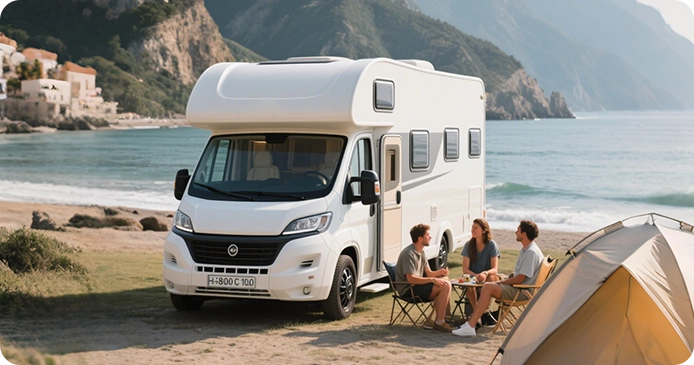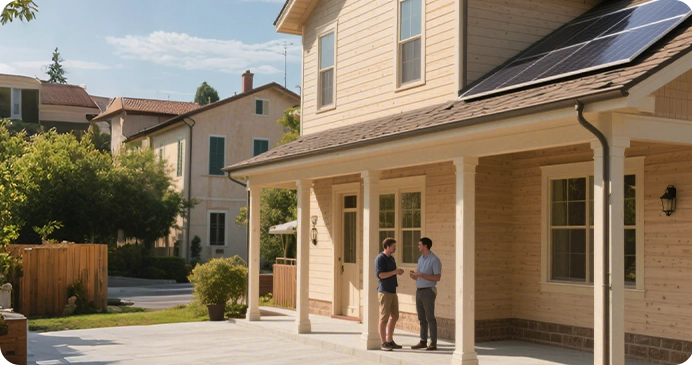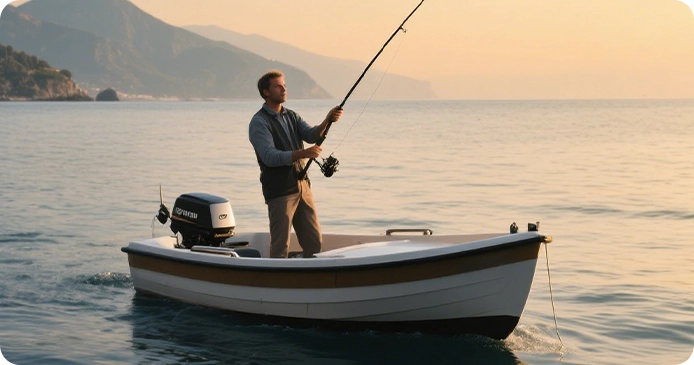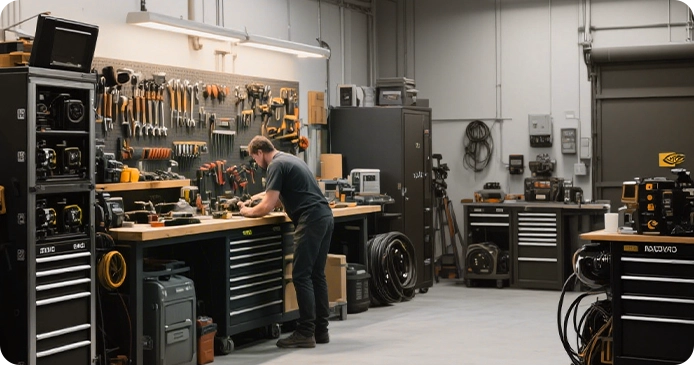
What Is The Best Deep Cycle Battery?
Heading off on a camping holiday, taking your fishing boat out, or putting together an off-grid solar installation? In all of these situations, a dependable deep-cycle battery sits at the heart of your power system, supplying steady electricity for equipment such as your motorhome fridge, interior lighting or trolling motor.
Unlike starter batteries in cars, which are built to deliver a brief surge of power to turn over an engine, deep-cycle batteries are engineered to provide sustained energy over many hours. That makes them essential when choosing the best deep-cycle RV battery or the best deep-cycle marine battery for regular use.
With so many technologies on the market, this guide explains why deep-cycle batteries matter, compares the main types, and offers practical advice to help you select the right option for camping, marine use or a solar storage battery, so you can rely on a consistent power supply.

What Is the Best Deep Cycle Battery and How Does It Work?
Where starter batteries are designed to deliver short, high-current bursts to start engines, deep-cycle batteries are intended to provide a steady output of power over a longer period.
They can be discharged much more deeply – often down to 80% of their capacity or even further – without lasting damage. This makes them well suited to running equipment such as fridges, lighting or trolling motors during camping trips, boating or off-grid living.
What distinguishes the best deep cycle battery is its robust internal construction. Lead-acid versions use thicker lead plates, while LiFePO4 models rely on advanced lithium chemistry, allowing them to cope with repeated charge and discharge cycles.
The best 12V 100Ah deep cycle battery provides around 1,200Wh of usable energy, enough to power a 100W refrigerator for roughly 12 hours. This resilience is key when you need a reliable supply for more demanding tasks such as camping setups or small solar systems.
Deep-cycle batteries store energy using electrochemical reactions. In a lead-acid unit, lead plates react with a sulphuric acid electrolyte to produce electricity, while lithium batteries move lithium ions between positive and negative electrodes.
The combination of deep discharge capability and efficient recharging – particularly in LiFePO4 batteries with a cycle life of around 2,000–5,000 cycles – is what makes them stand out.
Vatrer 12V LiFePO4 batteries can power onboard electronics such as fish finders, making them highly versatile in compact installations where space is limited. This makes them a practical solution for deep-cycle use in marine environments or motorhomes.
Interested in more background on deep-cycle batteries? Have a look at the following:
What is a 12V deep-cycle battery?
Can I use a deep-cycle battery with LiveScope?
Comparing Common Types of Deep Cycle Batteries
To identify the best deep cycle battery for your needs, it helps to understand how the main types differ. Each technology has distinct advantages, making it more appropriate for specific uses such as marine, RV or solar applications.
Flooded Lead-Acid (FLA) Batteries
Flooded lead-acid batteries are generally the lowest-cost deep-cycle option. They use lead plates submerged in a liquid electrolyte (a mix of sulphuric acid and water). However, they demand regular care, including topping up with distilled water every one to three months and ensuring good ventilation to disperse hydrogen gas generated during charging. Thanks to a well-established recycling system (around 99% recyclable in the U.S.), they can be a cost-effective and relatively environmentally responsible choice. Their weight and the need to remain upright, though, make them less convenient for mobile uses such as small boats or trolling motors.
AGM (Absorbed Glass Mat) Batteries
AGM batteries are sealed, maintenance-free lead-acid units in which the electrolyte is held in fibreglass mats. They are resistant to vibration, can be fitted in various orientations and are well suited as deep-cycle batteries for camping or RVs. Typically, they offer around 500–800 cycles at 50% depth of discharge and a service life in the region of 5–8 years. Their mid-range cost and durability make them a flexible option for motorhomes and boats.
Gel Batteries
Gel batteries are another sealed lead-acid design, using a gelled electrolyte that greatly reduces the risk of spills and improves performance in a wider temperature range. They are designed for deeper cycling (up to roughly 800 cycles at 50% DoD), which suits marine electronics, RV installations or light industrial use. That said, they are usually more expensive than standard AGM units and tend to have slightly lower discharge rates, so they are not ideal for very high current demands.
Lithium-Ion (LiFePO4) Batteries
Lithium Iron Phosphate (LiFePO4) batteries are increasingly seen as the benchmark for the best 12V deep cycle battery because they are lighter, have a longer lifespan and are more efficient. They are effectively maintenance-free, can charge up to around five times faster than lead-acid, and can be discharged to 100% of their rated capacity without harm. At 80% DoD, they typically achieve 2,000–5,000 cycles, significantly outlasting other deep-cycle technologies. An integrated battery management system (BMS) helps to protect against overcharging, overheating and thermal runaway, which makes them a strong candidate when you are choosing a solar battery for home storage or a deep-cycle battery for RVs.
Why Lithium (LiFePO4) Excels for Deep Cycle Needs
Compared with traditional lead-acid deep-cycle batteries, lithium solutions perform better in almost every area (deep discharge capability up to around 80%, rapid charging, no routine maintenance and more). This is why they have become the preferred option in many deep-cycle scenarios. Their key advantages include:
- Longer Lifespan: Around 2,000–5,000 cycles at 80% DoD versus roughly 200–500 cycles for many lead-acid batteries, which means far fewer replacements over time.
- Higher Efficiency: Able to deliver close to 100% of their rated capacity across different discharge rates, while lead-acid batteries may lose 20–30% under heavier loads.
- Faster Charging: Can accept higher charge currents (for example up to about 0.5C), which works particularly well with the best deep cycle battery charger paired with MPPT charge controllers that can improve solar harvesting efficiency by roughly 20–30% compared with PWM units.
- Lightweight Design: Typically 50–70% lighter than comparable lead-acid batteries, making transport and installation easier for camping, boating or caravanning.
- Safety: BMS protection and compliance with standards such as UL 1973/UN 38.3 help to prevent overcharge, overheating and short circuits.
- Temperature Resilience: Can retain around 90% of capacity at 0°C, whereas lead-acid batteries may fall to 50–60% under the same conditions.
Consider the Vatrer 12V 100Ah trolling motor battery. It is capable of powering a 55lbs thrust motor at half speed for roughly 4–5 hours, while an AGM deep-cycle battery of similar capacity is likely to manage only about 2–3 hours.
Powering Your Adventures with the Best Deep Cycle Battery
Deep-cycle batteries are highly adaptable and can support many different uses where continuous power is required. The ideas below can guide you towards the most suitable technology for your situation:
- Camping: The best deep-cycle camping batteries can run fridges, lights or small fans on off-grid camping trips.
- Boating: The best deep-cycle marine batteries are ideal for trolling motors, fish finders and navigation electronics.
- RVing: The best deep-cycle RV batteries can support appliances such as microwaves, pumps or air conditioning units.
- Solar Systems: The best deep-cycle solar batteries store energy from solar panels to supply power for off-grid homes, cabins or garden offices.
- Industrial: Deep-cycle batteries designed for traction or motive power can drive forklifts, golf carts or provide back-up power for critical systems.
Alongside choosing a technology, you also need to think about how much energy you will use. As an example, a motorhome user might require around 1,200 watt-hours per day: a 100W fridge (about 800Wh over 8 hours), a 20W light (roughly 100Wh over 5 hours) and a 30W phone charger (around 300Wh, enough for approximately ten charges).
Purchasing a group 24 best deep cycle battery with 100Ah capacity (around 1,200Wh of stored energy) can comfortably cover this requirement and provide dependable power for a week-long break.
You can also use Vatrer's online calculator to create a tailored power plan based on your specific energy usage.
Want to understand more about how deep-cycle batteries support different types of equipment? The following articles offer additional detail to help you finalise your choice:
What Is a Deep Cycle Lithium Battery Used For?
What Is The Best Deep Cycle Battery For a RV
Key Factors to Find Your Best Deep Cycle Battery
Choosing the best deep cycle battery is about striking the right balance between power demand, operating conditions and budget. The steps below can help structure your decision:
- Energy Consumption: Estimate your total daily energy use in watt-hours and then add a safety margin of about 20–30% battery capacity to reduce deep discharges and extend battery life.
- Application and Environment: Match the battery chemistry to the conditions. For the best deep-cycle battery for a trolling motor, for instance, a lithium-ion or AGM battery is a good choice because of its vibration resistance. For the best deep-cycle battery for solar power, a lithium-ion battery pairs well with MPPT controllers and supports faster, more efficient charging.
- Budget: As a rough guide, a 100Ah flooded lead-acid battery may cost around $100–$200, AGM around $200–$400, gel about $250–$450 and lithium typically $500–$1,000. While lithium is more expensive initially, its longer lifespan and fewer replacements generally lead to lower lifetime costs.
- Charging Compatibility: Lithium batteries work best with MPPT regulators or dedicated lithium chargers that follow the correct charge profile. Lead-acid batteries can be used with PWM or standard chargers but require regular maintenance to prevent sulphation.
The table below summarises the main battery types for quick comparison, highlighting cost, expected life and typical uses:
| Battery Type | Upfront Cost (12V 100Ah) | Lifespan (Cycles at 80% DoD) | Maintenance | Best For |
|---|---|---|---|---|
| Flooded Lead-Acid | $100-$200 | 200-500 | High (water, ventilation) | Budget, stationary use |
| AGM | $200-$400 | 500-800 | None | RVs, marine, camping |
| Gel | $250-$450 | 500-800 | None | Marine, RVs, industrial |
| Lithium (LiFePO4) | $500-$1,000 | 2,000-5,000 | None | Solar, marine, RVs, long-term use |
Conclusion
The best deep cycle battery for you will depend on your specific requirements, but LiFePO4 batteries stand out for their long life, high efficiency and strong safety profile. This makes them an excellent option for the best deep cycle battery for solar, the best deep cycle marine battery or the best deep cycle battery for camping.
If your main priority is keeping initial costs low, flooded lead-acid or AGM batteries can still be appropriate, provided you are prepared to carry out the necessary maintenance.
By working out your power needs, considering the environment in which the battery will operate and choosing a reputable manufacturer such as Vatrer Battery, you can support your trips and projects with confidence.
FAQs/People Also Ask
Who Makes the Best Deep Cycle Battery?
A number of established manufacturers offer reliable deep-cycle batteries. Solutions such as Vatrer Battery products are well suited to deep-cycle roles in marine craft, motorhomes and solar systems. For instance, the Vatrer 12V 100Ah and 200Ah batteries deliver around 2,000–5,000 cycles at 80% depth of discharge and include an integrated BMS plus Bluetooth connectivity for monitoring charge status in real time.
What Is the Best Deep Cycle Battery for Solar?
LiFePO4 batteries can accept relatively high charge currents, which pairs very effectively with MPPT solar charge controllers. Compared with PWM regulators, MPPT units can increase usable solar harvest by around 20–30%. Unlike many lead-acid batteries, which lose capacity when discharged quickly, lithium iron phosphate batteries maintain a more stable output, which is particularly important when solar input varies throughout the day. For this reason, deep-cycle lithium batteries are often the most suitable choice for storing solar energy in off-grid homes or holiday cabins.
Share



















































